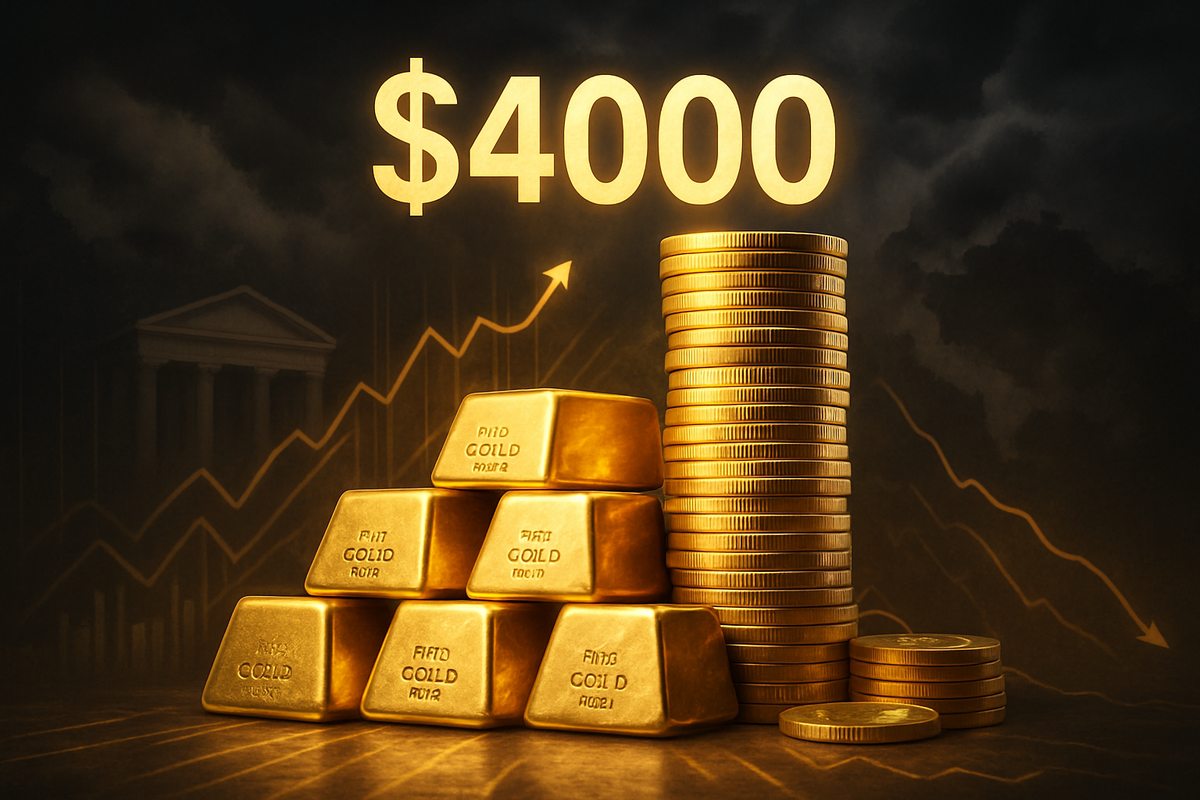
Gold, the age-old safe haven, is currently experiencing an unprecedented and historic rally, surging to the cusp of $4,000 per ounce in October 2025. This remarkable ascent, which has seen the precious metal's price soar by nearly 50% year-to-date, is fundamentally driven by a powerful confluence of factors: massive inflows into gold-backed Exchange Traded Funds (ETFs), mounting expectations of aggressive Federal Reserve interest rate cuts, and a deepening landscape of global economic and geopolitical turmoil. The immediate implication is a significant shift in investor sentiment towards tangible assets, signaling a collective loss of confidence in conventional financial instruments amidst an increasingly uncertain world.
The Golden Tide: Unpacking the Unprecedented Surge
The journey to this historic milestone has been swift and relentless. As of October 6, 2025, the spot price of gold hovers between $3,946 and $3,967 per ounce, having touched an intraday peak of approximately $3,949.34. This places it tantalizingly close to the psychological $4,000 barrier, a level previously unimaginable to many market observers. The rally's trajectory saw gold breach $2,900 per ounce in February 2024, cross $3,500 by April 2024, surpass $3,000 in March 2025, and push beyond $3,800 an ounce by September 2025, culminating in its current near-$4,000 valuation.
A primary catalyst for this surge has been the overwhelming investor demand channeled through gold-backed ETFs. These funds have witnessed a staggering influx of capital, with global gold ETFs recording US$5.5 billion in August 2025 alone, extending a three-month streak of positive flows. By August 2025, the total assets under management (AUM) for global gold ETFs reached a new record of US$407 billion, with year-to-date inflows amounting to US$47 billion—the second strongest on record after 2020. September 2025 saw a further $9 billion specifically directed towards funds holding physical gold, indicating a strong preference for direct exposure to the metal. This sustained buying pressure from institutional and retail investors alike underscores a defensive pivot in portfolios.
Simultaneously, the market's conviction in imminent Federal Reserve interest rate cuts has significantly bolstered gold's appeal. Current market probabilities suggest a 95% chance of a 25 basis-point (bps) rate cut in October 2025, followed by an 84% likelihood of another similar cut in December 2025. Lower interest rates typically reduce the opportunity cost of holding non-yielding assets like gold, making it a more attractive investment compared to bonds or other interest-bearing instruments. Statements from Fed officials hinting at necessary sharp rate reductions in response to economic conditions have further cemented these expectations, providing a strong tailwind for the yellow metal.
The backdrop of pervasive global turmoil completes the trifecta of drivers. Mounting geopolitical tensions, including the persistent Israel-Hamas conflict and the ongoing Russia-Ukraine war, have amplified demand for traditional safe-haven assets. Domestically, threats of a U.S. government shutdown, concerns over burgeoning national debt, and anxieties regarding the long-term stability of the U.S. dollar are pushing investors towards gold. Furthermore, a broader trend of de-dollarization, with central banks worldwide diversifying their reserves, has played a crucial role. Central banks acquired over 1,000 tons of gold for the third consecutive year in 2024, signaling a collective loss of confidence in conventional assets and policy efficacy in an era of deep economic uncertainty and geopolitical fragmentation. This flight to safety reflects a strong defensive posture among investors.
Corporate Fortunes: Winners and Losers in the Golden Era
The meteoric rise in gold prices presents a clear delineation of winners and losers across various sectors, profoundly impacting public companies tied to the precious metal.
Winners are predominantly found within the gold mining sector. Companies such as Barrick Gold Corporation (NYSE: GOLD), Newmont Corporation (NYSE: NEM), and Agnico Eagle Mines Limited (NYSE: AEM) stand to benefit immensely. Higher gold prices directly translate to increased revenue and expanded profit margins for these miners, assuming their production costs remain relatively stable. Their existing reserves become significantly more valuable, potentially leading to increased exploration budgets and the development of previously uneconomical deposits. Investors are likely to see their stock prices appreciate, and many of these companies may increase dividend payouts or initiate share buyback programs, further rewarding shareholders. Beyond the major players, junior mining companies with promising gold prospects could also attract significant investment and see their valuations soar.
Investment firms and asset managers specializing in precious metals or commodity-focused ETFs are also clear beneficiaries. Companies like BlackRock (NYSE: BLK) and State Street Corporation (NYSE: STT), which manage popular gold ETFs (e.g., iShares Gold Trust and SPDR Gold Shares, respectively), will see their assets under management (AUM) swell dueading to higher management fees. Additionally, financial institutions that offer gold-backed derivatives or provide financing to mining operations may experience increased business volumes and profitability.
Conversely, Losers in this golden rally are less direct but still significant. Industries heavily reliant on gold as a raw material, such as jewelry manufacturers and certain high-tech electronics companies, will face increased input costs. Jewelry retailers like Tiffany & Co. (NYSE: TIF, now part of LVMH) or Signet Jewelers Limited (NYSE: SIG) may struggle with margin compression if they cannot fully pass on the higher costs to consumers, or they might see a dip in demand for gold-heavy pieces as prices climb. While some might pivot to alternative materials or designs, the core business model for many will be challenged.
Furthermore, companies whose business models thrive in periods of low inflation and stable economic growth might indirectly suffer as the gold rally often signals underlying economic anxieties and inflationary pressures. For instance, some consumer discretionary companies could see reduced spending if household budgets are squeezed by broader economic uncertainty, even if not directly impacted by gold prices. Finally, investors who have significant short positions on gold or gold mining stocks would incur substantial losses as the price continues its upward trajectory.
Broader Implications: A Shifting Economic Landscape
Gold's historic rally is not merely a reflection of market dynamics; it is a profound indicator of a shifting global economic and geopolitical landscape, with wide-ranging implications that extend far beyond the immediate financial markets. This surge fits squarely into a broader trend of de-globalization and a re-evaluation of sovereign risk. The aggressive gold accumulation by central banks, particularly those of emerging economies, underscores a strategic move away from U.S. dollar dominance and towards a more diversified reserve asset base. This trend of de-dollarization signals a growing distrust in fiat currencies and a return to tangible assets as a store of value, challenging the long-standing international monetary order.
The ripple effects on competitors and partners are multifaceted. For other commodity markets, gold's performance can act as a leading indicator. A strong gold price often correlates with increased investor interest in other precious metals like silver and platinum, or even broader commodity indices, as investors seek inflation hedges. However, a surging gold price can also divert capital from other investment opportunities, potentially impacting sectors that rely on robust equity inflows. For nations, particularly those with significant gold reserves or mining operations, the rally can strengthen their economic positions and provide a buffer against currency fluctuations and external shocks.
Regulatory and policy implications are also significant. Governments and central banks might face increased pressure to manage inflation if the gold rally is indeed a harbinger of rising price levels. This could influence monetary policy decisions, potentially leading to a more hawkish stance from central banks even amidst calls for rate cuts, creating a delicate balancing act. Furthermore, the increased scrutiny on gold flows and ownership could lead to new regulations, particularly in areas related to anti-money laundering (AML) and combating the financing of terrorism (CFT), given gold's historical role in illicit finance. The debate around the role of gold in the international monetary system could also reignite, potentially leading to discussions about gold-backed currencies or greater gold reserves requirements.
Historically, gold rallies of this magnitude have often coincided with periods of significant economic stress, high inflation, or geopolitical instability. The 1970s, characterized by oil shocks and stagflation, saw gold prices skyrocket. Similarly, the aftermath of the 2008 financial crisis witnessed a substantial run-up in gold as investors sought safety. The current environment, with its unique blend of post-pandemic inflation, persistent geopolitical conflicts, and unprecedented national debt levels, draws parallels to these historical precedents, suggesting that the market is bracing for prolonged uncertainty. This comparison highlights gold's enduring role as a reliable hedge against systemic risk and a barometer of global confidence.
What Comes Next: Navigating the Golden Horizon
The path forward for gold, while seemingly clear in its upward trajectory, presents a complex interplay of short-term volatility and long-term strategic shifts. In the short term, the market will be keenly watching upcoming Federal Reserve announcements. A confirmed rate cut in October 2025, followed by further dovish signals, would likely provide additional impetus for gold to breach and consolidate above the $4,000 mark. Any unexpected hawkish pivot from the Fed, however, could trigger a temporary correction as the allure of yielding assets returns. Geopolitical developments, particularly any escalation or de-escalation of existing conflicts, will also heavily influence gold's safe-haven demand. Analysts from Trading Economics estimate gold to trade at $3940.51 by the end of the current quarter and $4111.97 in 12 months, while HSBC anticipates gold could exceed $4,000 per ounce in the near term and continue climbing through 2026. Goldman Sachs also projects gold to reach $4,000 per troy ounce by mid-2026.
In the long term, the structural drivers behind gold's rally—de-dollarization, central bank diversification, and persistent global instability—suggest a sustained bullish outlook. This could necessitate strategic pivots for various market participants. Investors might increasingly allocate a larger portion of their portfolios to precious metals as a core defensive strategy. Mining companies may accelerate exploration and production efforts, potentially leading to mergers and acquisitions to consolidate reserves and operational efficiencies. Jewelry and industrial users of gold may need to innovate with alternative materials or streamline supply chains to mitigate cost pressures.
Market opportunities will emerge for companies specializing in gold-backed financial products, secure storage solutions, and advanced mining technologies. Challenges will include managing the volatility inherent in commodity markets and navigating potential regulatory changes. Potential scenarios range from a continued, steady ascent towards $5,000 per ounce if geopolitical tensions persist and central banks continue their buying spree, to a more volatile "boom and bust" cycle if economic stability temporarily returns or if a major shift in monetary policy occurs. A less likely but possible scenario involves a significant global economic recovery, which could dampen gold's appeal, though current indicators suggest otherwise.
Comprehensive Wrap-up: Gold's Enduring Significance
Gold's historic rally nearing $4,000 per ounce is a landmark event in financial markets, underscoring a profound shift in investor psychology and global economic dynamics. The confluence of robust ETF inflows, aggressive Fed rate cut expectations, and an escalating landscape of global turmoil has propelled the yellow metal to unprecedented heights. This rally is not merely a speculative bubble; it represents a fundamental re-evaluation of risk and value in an increasingly uncertain world, with investors and central banks alike seeking refuge in tangible assets.
Moving forward, the market will remain highly sensitive to monetary policy signals from the Federal Reserve and developments on the geopolitical front. The sustained trend of de-dollarization and central bank gold accumulation suggests that gold's role as a strategic reserve asset is strengthening, cementing its position as a critical component of global financial stability. The implications for public companies are clear: gold miners stand to gain significantly, while gold-dependent industries face margin pressures.
Investors should watch for continued central bank buying, the pace and magnitude of Fed rate cuts, and the evolution of global conflicts. Gold's enduring significance as a safe haven, an inflation hedge, and a store of value is being reaffirmed in this historic period. Its journey towards and potentially beyond $4,000 per ounce marks a new chapter in its long and storied history, signaling a deeper distrust in conventional assets and a profound shift towards tangible wealth in an era defined by uncertainty.
This content is intended for informational purposes only and is not financial advice







